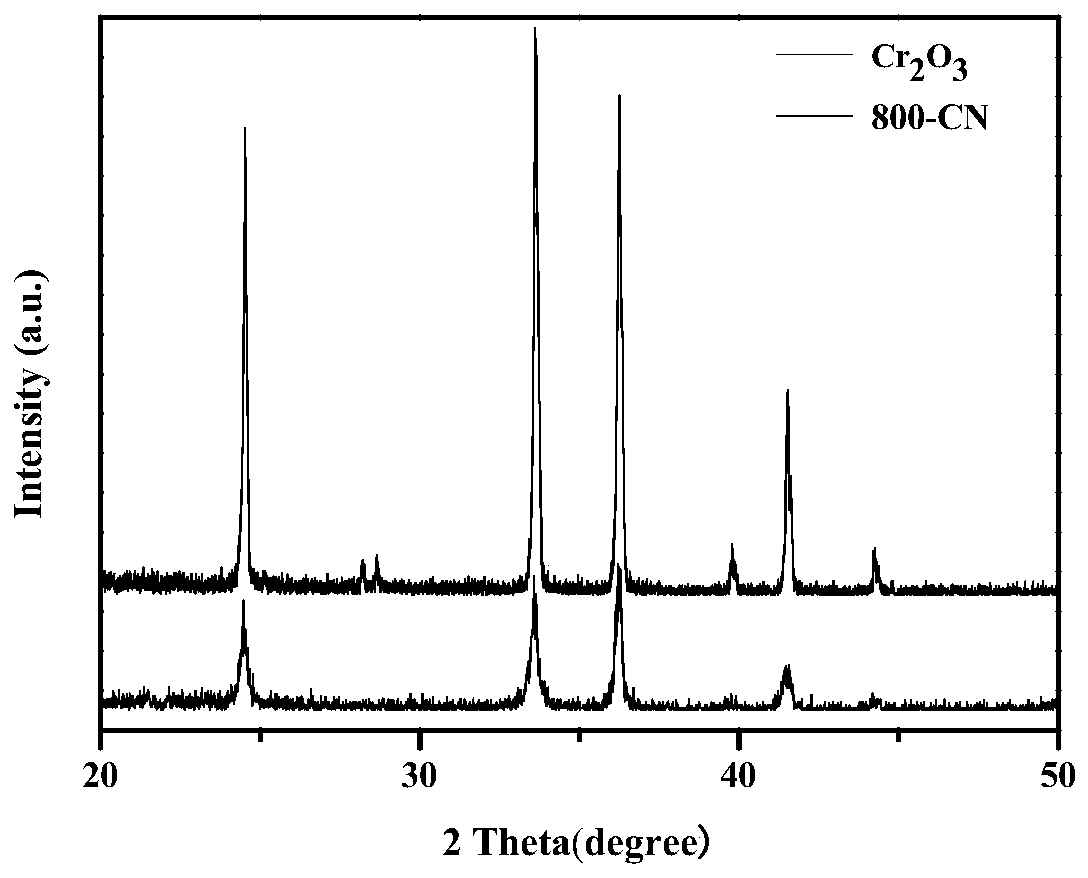Carbon nitride compounded chromium sesquioxide oxygen-vacancy-containing photo-thermal catalyst as well as preparation method and application thereof
A technology of chromium trioxide and carbon nitride, which is used in physical/chemical process catalysts, chemical instruments and methods, separation methods, etc., can solve problems such as low catalytic activity, achieve no environmental pollution, reduce costs, and inhibit current-carrying. The effect of subcompositing
- Summary
- Abstract
- Description
- Claims
- Application Information
AI Technical Summary
Problems solved by technology
Method used
Image
Examples
Embodiment 1
[0021] Photothermal Catalysts Containing Oxygen Defects in Chromium Trioxide Composite with Carbon Nitride
[0022] (1) The preparation method is as follows
[0023] Dissolve 2.52g of melamine and 4g of chromium nitrate nonahydrate in 80ml of deionized water, stir for 1 hour, and dry at 60°C to obtain a precursor.
[0024] The precursor was ground and calcined at 500°C for 2h in the air environment with a heating rate of 5°C / min to obtain a carbon nitride composite chromium trioxide photothermal catalyst containing oxygen defects, marked as 500-CN.
[0025] (2) Detection
[0026] figure 1 500-CN prepared for Example 1 and pure Cr 2 o 3 The XRD test pattern, by figure 1 It can be seen that the sample 500-CN has diffraction peaks at 24.6°C, 33.7°C, 36.3°C, 40.0°C and 41.5°C, which are different from pure Cr 2 o 3 The characteristic peaks are similar, which proves that 500-CN has been successfully synthesized, and the sample 500-CN does not have two diffraction peaks at 13...
Embodiment 2
[0028] Photothermal Catalysts Containing Oxygen Defects in Chromium Trioxide Composite with Carbon Nitride
[0029] (1) The preparation method is as follows
[0030] Dissolve 2.52g of melamine and 4g of chromium nitrate nonahydrate in 80ml of deionized water, stir for 1 hour, and dry at 60°C to obtain a precursor.
[0031] The precursor was ground and calcined at 600°C for 2 hours in an air environment with a heating rate of 5°C / min to obtain a carbon nitride composite chromium trioxide photothermal catalyst containing oxygen defects, marked as 600-CN.
[0032] (2) Detection
[0033] figure 2 600-CN prepared for Example 2 and pure Cr 2 o 3 The XRD test pattern, by figure 2 It can be seen that the sample 600-CN has diffraction peaks at 24.6°C, 33.7°C, 36.3°C, 40.0°C and 41.5°C, which is similar to that of pure Cr 2 o 3 The characteristic peaks are similar, which proves that 600-CN has been successfully synthesized, and the sample 600-CN does not have two diffraction pe...
Embodiment 3
[0035] Photothermal Catalysts Containing Oxygen Defects in Chromium Trioxide Composite with Carbon Nitride
[0036] (1) The preparation method is as follows
[0037] Dissolve 2.52g of melamine and 4g of chromium nitrate nonahydrate in 80ml of deionized water, stir for 1 hour, and dry at 60°C to obtain a precursor.
[0038] The precursor was ground and calcined at 800°C for 2h in the air environment with a heating rate of 5°C / min to obtain a carbon nitride composite chromium trioxide photothermal catalyst containing oxygen defects, marked as 800-CN.
[0039] (2) Detection
[0040] image 3 500-CN prepared for Example 3 and pure Cr 2 o 3 The XRD test pattern, by image 3 It can be seen that the sample 800-CN has diffraction peaks at 24.6°C, 33.7°C, 36.3°C, 40.0°C and 41.5°C, which are different from pure Cr 2 o 3 The characteristic peaks are similar, which proves that 800-CN has been successfully synthesized, and the sample 800-CN does not have two diffraction peaks at 13...
PUM
 Login to View More
Login to View More Abstract
Description
Claims
Application Information
 Login to View More
Login to View More - R&D
- Intellectual Property
- Life Sciences
- Materials
- Tech Scout
- Unparalleled Data Quality
- Higher Quality Content
- 60% Fewer Hallucinations
Browse by: Latest US Patents, China's latest patents, Technical Efficacy Thesaurus, Application Domain, Technology Topic, Popular Technical Reports.
© 2025 PatSnap. All rights reserved.Legal|Privacy policy|Modern Slavery Act Transparency Statement|Sitemap|About US| Contact US: help@patsnap.com



